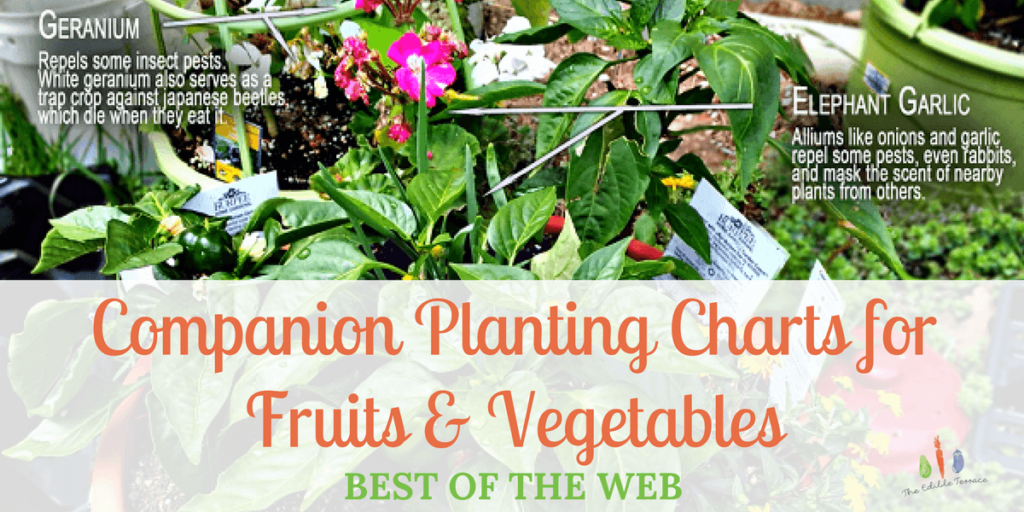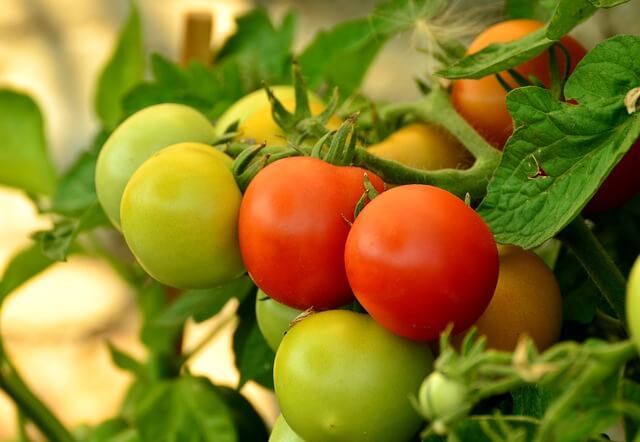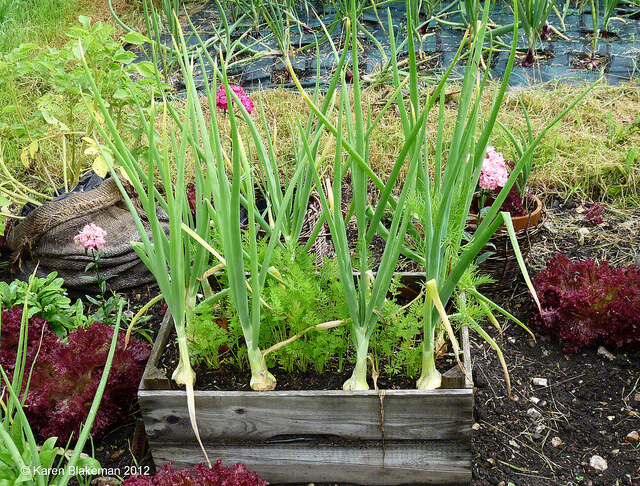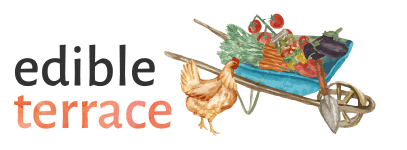Hey! By the way… TheEdibleTerrace is reader-supported. When you buy through links on our site, we may earn an affiliate commission and as an Amazon affiliate, we earn from qualifying purchases. Thanks in advance for your support!

Carrots Love Tomatoes: Secrets of Companion Planting for Successful Gardening Companion planting charts for vegetables abound on the Internet. In case you are new to this gardening technique, it is the art of planting certain garden plants next to each for the purpose of either improving pest control, saving space or enhancing the growth of your edibles.
Companion planting charts for vegetables abound on the Internet. In case you are new to this gardening technique, it is the art of planting certain garden plants next to each for the purpose of either improving pest control, saving space or enhancing the growth of your edibles.
Think plant synergy. This is an important consideration given that we gardeners are short on space and must maximize what we have.
To help make things easier for you, I hunted down the best companion planting charts for vegetables, rated them and share the best of the web with you. Oh, and they had to be free! Let’s get ready to rumble!
UC Davis Good Life Garden offers a list of why it is smart to companion plant.
- Trap Cropping: This is where you plant two plants side by side with one meant to attract pests away from the other.
- Symbiotic Nitrogen Fixation: Legumes and clover both put nitrogen back into the soil thus reducing the need for extra fertilizer. As an example, corn typically needs more nitrogen.
- Physical Spatial Interactions: This is where a taller plant is grown next to a shorter one that needs shade.
- Beneficial Habitats: A habitat is created to attract beneficial insects to your garden. I.e. ladybugs, hoverflies, spiders, wasps, etc. These beneficial insects eat the pests that munch on your vegetables when you’re not looking.
- Security through Diversity: By diversifying your vegetables and herbs, if something does happen to one crop you have others that hopefully are still thriving.

Companion Vegetable Planting Guide
1. Wikipedia List of Companion Plants
Interestingly, one of the most comprehensive List of Companion Plants articles we found was on Wikipedia. Big shout out to the horticulturalists that have clearly spent hours toiling over that page! Not only does the table list vegetables, fruit, herbs and flowers but it also lists out which pests are attracted and repelled to each one and gives helpful comments.
For example, did you know Alyssum, Baby’s Breath and California Poppy’s attract hoverflies (Syrphidae)? This is important as the hoverfly likes to eat aphids which if you are not aware, are troublemakers for many vegetables. The downside to this article is it does not print in an attractive, easy to read format.
David’s Garden Seeds Sweet Alyssum (White) 500 Open Pollinated Seeds David’s Garden Seeds Flower Baby’s Breath Mixed 500 Open Pollinated Seeds
David’s Garden Seeds Flower Baby’s Breath Mixed 500 Open Pollinated Seeds David’s Garden Seeds Poppy California Dreaming Mix 500 Open Pollinated
David’s Garden Seeds Poppy California Dreaming Mix 500 Open Pollinated
2. ATTRA Companion Planting: Basic Concepts & Resources
This report is on my alma-mater’s website. <Go Sun Devils!> It gives detailed scientific evidence behind companion planting and beneficial plant associations.
David’s Garden Seeds Three Sisters Organic Heirloom Garden Package D92001 Multi 250 Organic Heirloom Seeds There is even a fun appendix at the end that gives the story of the “Three Sisters.” Some of the Native American tribes grow corn, beans and squash together because they are considered gifts from Great Spirit and thus protected by the Three Spirits sisters.
There is even a fun appendix at the end that gives the story of the “Three Sisters.” Some of the Native American tribes grow corn, beans and squash together because they are considered gifts from Great Spirit and thus protected by the Three Spirits sisters.
The downside is this list of companion plants is not the most attractive and limited to only the most popular edibles. It is in pdf form though so easy to print and carry outside to your Edible Terrace!
The story of the “Three Sisters”
Some of the Native American tribes grow corn, beans and squash together because they are considered gifts from Great Spirit and thus protected by the Three Spirits sisters.
The premise is that you first plant the corn which provides support to the pole beans. Squash is planted nearby to provide shade for the roots. Additionally bean plant roots release nitrogen at the end of their growing season which is good for the corn.
3. Permaculture Research Institute Companion Planting Chart

The Permaculture Research Institute features quite an impressive printable Vegetable Companion Planting List! It is one big X-Y grid that lists almost 70 fruits and vegetables. A smiley face means the plants are companions and an X means they’re considered Antagonistic.
Off to the side, the pdf gives Natural Insect Repellent Tips. For example, ants are repelled by mint and garlic. In fact, I see garlic is a natural repellent for many pests! ** Due to the colors used, the chart is a little difficult to read when printed.
Garlic Bulb (3 Pack), Softneck For Planting And Growing

Onions or garlic planted around carrots are said to deter carrot flies
4. Yates Printable Companion Planting Chart for Vegetables and Fruit
 Yates, an Australian company that sells gardening products also has a beautifully detailed fruit and vegetable companion planting chart pdf with over 70 vegetables, fruits, flowers and herbs. This one is easier to read.
Yates, an Australian company that sells gardening products also has a beautifully detailed fruit and vegetable companion planting chart pdf with over 70 vegetables, fruits, flowers and herbs. This one is easier to read.
The colors are more contrasting making it friendlier on the eyes.
For those of us with reading glasses, keep them close by for this chart! There are some fun plants of which I have never heard though. Two are Lovage and Tansy.
5. University of Illinois Companion Planting instructional video
I should warn you the video below is 56 minutes. However, if you’re determined to learn everything you can, then do not overlook this resource.
The Marigold myth
We hear a lot about how marigolds should be planted in the gardens because they are an insecticide. That is true but…according to UMass Amherst, the benefits only occur after African or French marigolds are grown as a crop cover, then tilled into the soil afterward to release the chemicals that are toxic to pests.
They also state there is not very much evidence to support marigold’s superstar status. <Sigh. SoSad.>
Conclusion
There are so many articles about companion planting charts for vegetables and fruit out there. However, many were not from websites we would consider “experts.” And I wanted to give you expert opinions!
Why did I list Wikipedia then you ask? Because Wikipedia’s information is considered to be accurate 99.5% of the time. Additionally, if you go to the bottom of their article on List of Companion Plants, you will see they give 90 references. 90! There was a lot of loving going into that page!
We hope this was helpful to you in your quest to more efficiently find companion planting charts for vegetables – and herbs and fruit and flowers! If you feel we missed a strong contender for the expert vegetable companion plants chart, feel free to let us know in the comments.
Check out some of our most popular gardening articles.
Easy Steps To Growing Vegetables In A Small Space – Container Gardening
10 Pinteresting People Give Us Steps To Grow a Vegetable Garden
How To Easily Build an Elevated Vegetable Garden (Video)
15 Videos That Will Get You Started On Autumn & Winter Vegetable Gardening







